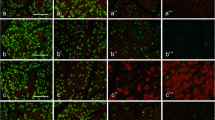Summary
The postnatal development of the submandibular gland was investigated in male mice of the Swiss-Webster strain, which were killed at 1, 2, 3, 4, 5, 6, 8, 10, 12, 16 and 20 weeks of age, while the older mice had been weaned at 3 weeks of age. The mean weight of the submandibular gland increases from 9.5 mg at 1 week to 232.9 mg at 20 weeks of age, and the rate of increase is rapid between 3 and 10 weeks of age. The gland's contents of DNA, RNA and protein increase in a similar manner.
The changes in the constituent cell types of the gland were studied in radioautographs prepared from Epon-embedded sections of mice given 3H-thymidine and stained with toluidine blue. At 1 week of age, the gland consists of acinar cells (36%), intercalated duct cells (26%), juxta-acinar cells (13%), striated duct cells (12%) and others. The cellular composition of the gland changes little before weaning, but the absolute number of all types of cells increases with age. Between 3 and 4 weeks, juxta-acinar cells disappear and granular convoluted tubule cells appear and increase rapidly in number with age. The rapid expansion of the population size of granular convoluted tubule cells after weaning coincides with the second peak of increased proliferative activity of intercalated duct cells, whereas all the other cell types show a progressive decrease in their proliferative activity with age. In spite of the burst in proliferative activity, there is no corresponding increase in the absolute number of intercalated duct cells. The number of striated duct cells peak at 5 weeks of age and then declines. These findings indicate that the mitoses of intercalated duct cells give rise to granular convoluted tubule cells through a stage of striated duct cells. At 20 weeks of age, the gland consists of granular convoluted tubule cells (47%), acinar cells (28%), intercalated duct cells (12%), striated duct cells (1%) and others.
Similar content being viewed by others
References
Alvares, E.P., Sesso, A.: Cell proliferation, differentiation and transformation in the rat submandibular gland during early postnatal growth. A quantitative and morphological study. Arch. Histol. Jap. 38, 177–208 (1975)
Barka, T., Chang, W., van der Noen, H.: Stimulation of DNA synthesis by isoproterenol in rat submandibular gland during postnatal growth. Cell Tissue Kinet. 6, 135–146 (1973)
Caramia, F.: Ultrastructure of mouse submandibular gland. I. Sexual differences. J. Ultrastruct. Res. 16, 505–523 (1966)
Chang, W.W.L.: Cell population changes during acinus formation in the postnatal rat submandibular gland. Anat. Rec. 178, 187–201 (1974)
Cohen, S.: Isolation of a mouse submaxillary gland protein accelerating incisor eruption an eyelid opening in the newborn animal. J. Biol. Chem. 237, 1555–1562 (1962)
Cutler, L.S., Chaudhry, A.P.: Cytodifferentiation of the acinar cells of the rat submandibular gland. Develop. Biol. 41, 31–41 (1974)
Dvorak, M.: The secretory cells of the submaxillary gland in the perinatal development in the rat. Z. Zellforsch. 99, 346–356 (1969)
Ekfors, T.O., Hopsu-Havu, V.K.: Immunofluorescent localisation of trypsin-like estero — peptidases in the mouse submandibular gland. Histochem. J. 3, 415–420 (1971)
Erdos, E.G., Tague, L.L., Miwa, L.: Kallikrein in granules of the submaxillary gland. Biochem. Pharmacol. 17, 667–674 (1968)
Gresik, E.W., MacRae, E.K.: The postnatal development of the sexually dimorphic duct system and of amylase activity in the submandibular glands of mice. Cell Tissue Res. 157, 411–422 (1975)
Jacoby, R., Leeson, C.R.: The postnatal development of the rat submaxillary gland. J. Anat. (Lond) 93, 201–216 (1959)
Kopriwa, B.M., Leblond, C.P.: Improvements in the coating technique for radioautography. J. Histochem. Cytochem. 10, 269–284 (1962)
Leeson, C.R., Jacoby, F.: An electron microscopic study of the rat submaxillary gland during its postnatal development and in the adult. J. Anat. 93, 287–295 (1959)
Levi-Montalcini, R.: The nerve growth factor. Ann. N.Y. Acad. Sci. 118, 149–170 (1964)
Mueller, H.B.: Die Speicheldrüsen junger Ratten nach Parasympathektomie. Z. Zellforsch. 88, 80–104 (1968)
Shear, M.: Ultrastructural studies of the intercalated ducts in rat parotid glands. S. Afr. J. Med. Sci. 34, 21–27 (1969)
Sreebny, L.M., Meyer, J., Bachem, E., Weinmann, J.P.: Postnatal changes in proteolytic activity and in the morphology of the submaxillary gland in male and female albino rats. Growth 19, 57–74 (1955)
Srinivasan, R., Chang, W.W.L., van der Noen, H., Barka, T.: The effect of isoproterenol on the postnatal differentiation and growth of the rat submandibular gland. Anat. Rec. 117, 243–253 (1973)
Srinivasan, R., Chang, W.W.L.: The development of the granular convoluted duct in the rat submandibular gland. Anat. Rec. 182, 29–40 (1975)
Takeda, T., Debusk, J., Grollman, A.: Physiologic role of renin like constituent of submaxillary gland of the mouse. Amer. J. Physiol. 216, 1196–1198 (1969)
Yamashina, S., Mizuhira, V.: Postnatal development of acinar cells in rat submandibular glands as revealed by electron microscopic staining for carbohydrates. Am. J. Anat. 146, 211–256 (1976)
Yohro, T.: Development of secretory units of mouse submandibular gland. Z. Zellforsch. 110, 173–186 (1970)
Author information
Authors and Affiliations
Additional information
Supported by Public Health Service Research Grant AMDE 19753 from the National Institute of Health. The authors are indebted to Mr. I. Borcsanyi for technical assistance
Rights and permissions
About this article
Cite this article
Srinivasan, R., Chang, W.W.L. The postnatal development of the submandibular gland of the mouse. Cell Tissue Res. 198, 363–371 (1979). https://doi.org/10.1007/BF00232017
Accepted:
Issue Date:
DOI: https://doi.org/10.1007/BF00232017




